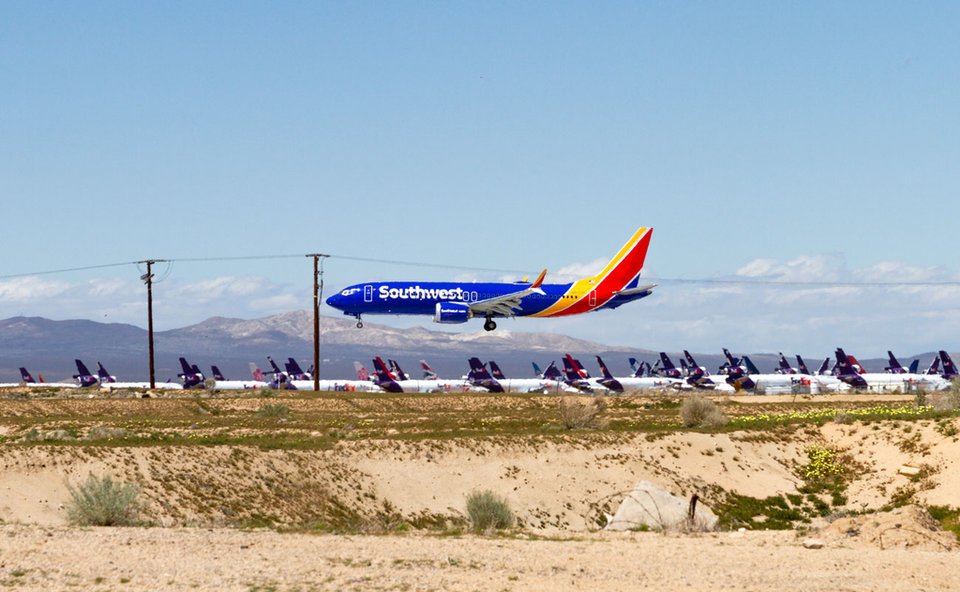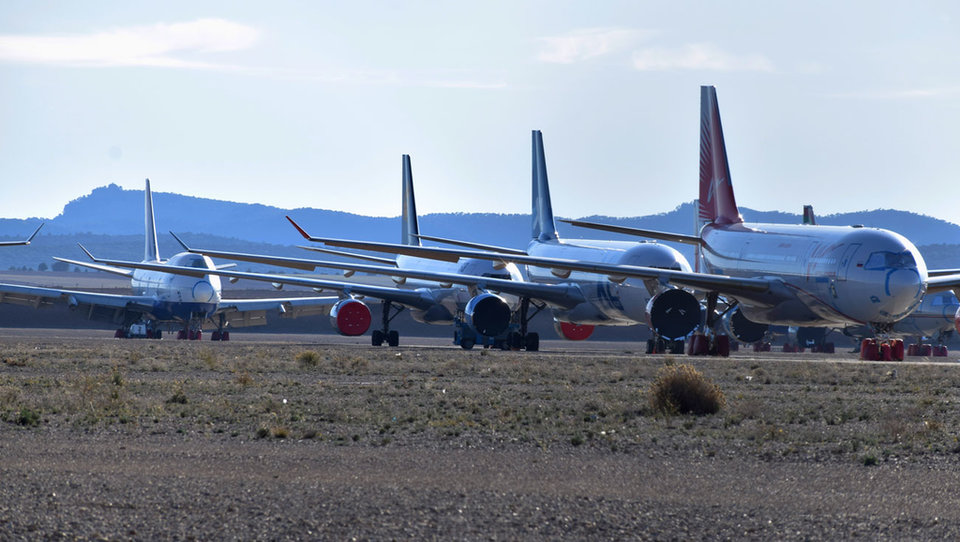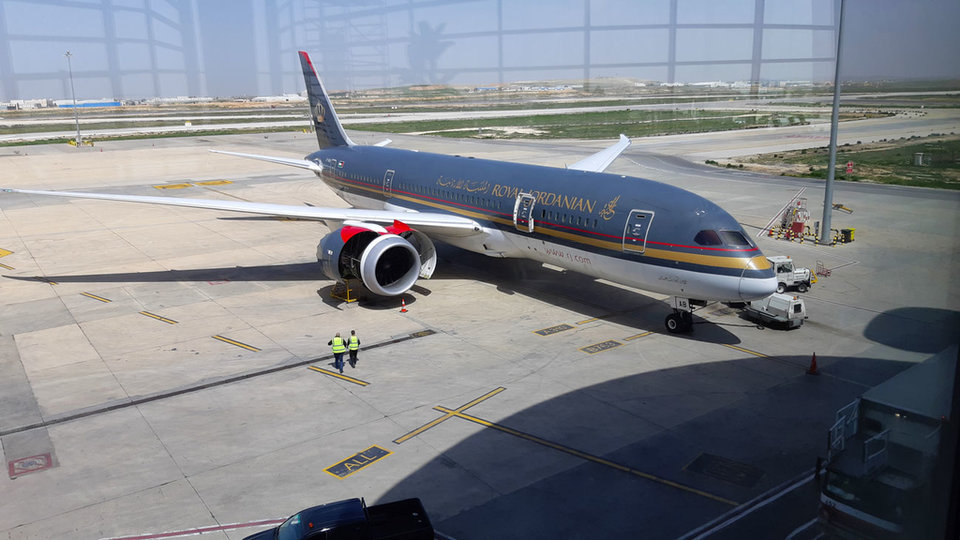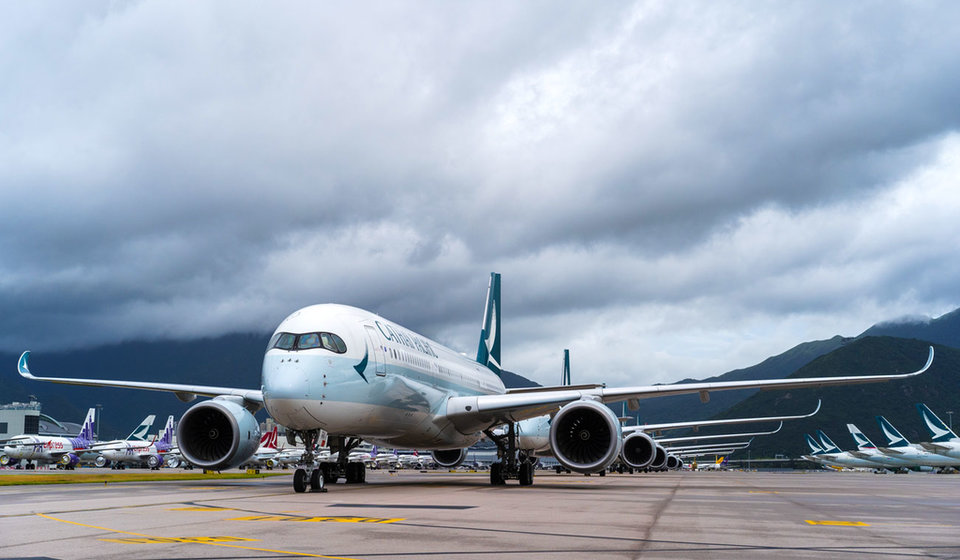AIRPORT OPERATIONS
Covid-19: where did all the aircraft go?
To remain afloat during the ongoing economic recession, airlines have been forced to implement extreme measures, such as tucking their aircraft into storage. Ilaria Grasso Macola looks at the facilities that have become hotspots for aircraft storage during the pandemic.
Data from the International Air Transport Association (IATA) shows that, between January and July, more than seven million flights were cancelled, resulting in the global aviation industry losing $84.3bn.
While the passenger numbers dried up, companies around the world resorted to money-saving measures, including grounding part of their fleet in storage facilities and hot and dry climates to limit airplane aircraft corrosion.
Here are some of the major hotspots where aircraft have been stored during the coronavirus crisis.
Image:
Southern California Logistics Airport – Victorville, US
Located in Victorville, a town in California’s San Bernardino Valley approximately 100km north of Los Angeles, Southern California Logistics Airport (SCLA) is one of the biggest aircraft boneyards in the US.
Originally an abandoned air force base, SCLA has become, amongst other things, a storage hub for commercial and cargo carriers including Boeing and FedEx since its redevelopment in 1999.
The airport – which can store more than 500 aircraft and 300 engines – is operated by US asset management firm ComAv Asset Management.
In July, it was reported that Australian airline Qantas flew the first A380 of its 12-plane fleet from Melbourne to SCLA, while in March Delta Airlines decided to park its fleet to cut costs in the wake of coronavirus travel restrictions.

A Southwest aeroplane arriving at Southern California Logistics Airport in Victorville, CA in March 2017. Image: Felipe Sanchez / Shutterstock.com
Teruel Airport – Teruel, Spain
Situated in the north-east of Spain between the cities of Zaragoza and Valencia, Teruel Airport is one of the biggest airports for plane storage in Europe. The airport accommodates around 90 planes, including the world’s biggest passenger plane model, the A380.
As the impact of the coronavirus pandemic was heavily felt across the industry, big airlines including British Airways and Air France began to store their planes in Teruel.
In April, Lufthansa decided to store three of its A340-600 fleet, with plans to park the entire 17-plane fleet at Teruel in the following months.
The company cited the planes’ limited use during the next year and a half as a main reason for the decision.
Built between 2009 with an initial investment of €40m, Teruel Airport was immediately developed as an industrial airport suitable for storing planes.
The airport is jointly owned by the regional government of Aragon and Teruel’s municipality.
In June 2020, the airport received authorisation to receive a limited amount of passenger flights, after planning the move for more than a year.
“We opened the commercial activity of the airport to the arrival of aircraft with passengers on a discretionary and to the use of the facilities for air taxis,” said the regional Minister of Territorial Planning, Mobility and Housing José Luis Soro.

Aircraft waiting to be recycled at Teruel Airport, Spain in October 2019. Image: Elvira1 / Shutterstock.com
Tarbes Lourdes Airport – Tarbes, France
The Tarbes Lourdes Airport is situated in the Pyrenees, in the south-western part of France, between the cities of Tarbes and Lourdes.
The pandemic’s impact is affecting Tarbes’s owner TARMAC Aerosave, which is reaching the maximum capacity at its four locations.
“Today there’s no (travel) demand. That is why we have more than 200 aircraft on our sites,” TARMAC Aerosave chief executive Patrick Lecer told Reuters.
Headquartered in Tarbes, the French storage and maintenance company’s other facilities include Toulouse’s Francazal Airport and Paris’s Vatry Airport.
The company is Europe’s largest storage company and partly owned by multinational aeronautical manufacturer Airbus, as well as by aerospace technology provider Safran and industrial services provider Suez.
Tarmac Aerosave recently received its 1,000th aircraft when a Macquarie Air Finance B737-800 landed at the Toulouse facility at the beginning of July.

A380 aircraft at TARMAC Aerosave’s facility in 2015. Image: Nicotrex / Shutterstock.com
Joramco – Amman, Jordan
On 3 May, aviation analyst Alex Macheras reported that seven Swiss International Airlines aircraft were en route to Amman, Jordan to be stored with Jordanian maintenance company Joramco.
According to Swiss news website aeroTELEGRAPH, the procession included five Airbus A320 and two Airbus A330, which are not expected to be used for more than three months.
“It is particularly recommended in situations where the aircraft will not be needed for operational use for more than three months,” a Swiss spokesperson told the website.
Storage operations, said the company, are different from simple parking. During storage operations, tests are implemented to check the planes’ status.
Joramco has a five-year partnership with Swiss and on 24 June, the Swiss ambassador visited the Joramco facility.

A380 aircraft at TARMAC Aerosave’s facility in 2015. Image: Nicotrex / Shutterstock.com
Alice Springs Airport – Alice Springs, Australia
After deciding to cut 96% of its capacity, Singapore Airlines started to ground 138 of its 147 SIA and SilkAir Aircraft fleet at the end of March. Out of the total number of planes, several have gone to Alice Springs Airport, the only aircraft storage facility in the Asia-Pacific region.
As reported by Australian news website News.com.au, the facility was already maintaining six Boeing MAX 8s and 13 narrow-body aircraft when the Singapore planes landed.
Situated in Australia’s Northern Territory, the airport is owned by Australian aircraft maintenance company Asia Pacific Aircraft Storage.
Alice Springs Airport stretches over 3,500 hectares of land and, given its position in the Australian outback, has unlimited expansion capabilities. The outback’s dry climates make Alice Springs a perfect location to store planes.

Cathay Pacific began to move one-third of its Cathay Pacific and Cathay Dragon fleet to Alice Springs, Australia in July. Image: Terry K / Shutterstock.com
Southern California Logistics Airport – Victorville, US
Located in Victorville, a town in California’s San Bernardino Valley approximately 100km north of Los Angeles, Southern California Logistics Airport (SCLA) is one of the biggest aircraft boneyards in the US.
Originally an abandoned air force base, SCLA has become, amongst other things, a storage hub for commercial and cargo carriers, including Boeing and FedEx, since its redevelopment in 1999.
The airport – which can store more than 500 aircraft and 300 engines – is operated by US asset management firm ComAv Asset Management.
In July, it was reported that Australian airline Qantas flew the first A380 of its 12-plane fleet from Melbourne to SCLA, while in March Delta Airlines decided to park its fleet to cut costs in the wake of coronavirus travel restrictions.

A Southwest aeroplane arriving at Southern California Logistics Airport in Victorville, CA in March 2017. Image: Felipe Sanchez / Shutterstock.com
Teruel Airport – Teruel, Spain
Situated in the north-east of Spain between the cities of Zaragoza and Valencia, Teruel Airport is one of the biggest airports for plane storage in Europe. The airport accommodates around 90 planes, including the world’s biggest passenger plane model, the A380.
As the impact of the coronavirus pandemic was heavily felt across the industry, big airlines, including British Airways and Air France, began to store their planes in Teruel.
In April, Lufthansa decided to store three of its A340-600 fleet, with plans to park the entire 17-plane fleet at Teruel in the following months.
The company cited the planes’ limited use during the next year and a half as the main reason for the decision.
Built between 2009 and 2013 with an initial investment of €40m, Teruel Airport was immediately developed as an industrial airport suitable for storing planes.
The airport is jointly owned by the regional government of Aragon and Teruel’s municipality.
In June 2020, the airport received authorisation to receive a limited amount of passenger flights, after planning the move for more than a year.
“We opened the commercial activity of the airport to the arrival of aircraft with passengers on a discretionary basis and to the use of the facilities for air taxis,” said the regional Minister of Territorial Planning, Mobility and Housing José Luis Soro.

Aircraft waiting to be recycled at Teruel Airport, Spain in October 2019. Image: Elvira1 / Shutterstock.com
Tarbes Lourdes Airport – Tarbes, France
The Tarbes Lourdes Airport is situated in the Pyrenees, in the south-western part of France, between the cities of Tarbes and Lourdes.
The pandemic’s impact is affecting Tarbes’s owner TARMAC Aerosave, which is reaching the maximum capacity at its four locations.
“Today there’s no (travel) demand. That is why we have more than 200 aircraft on our sites,” TARMAC Aerosave chief executive Patrick Lecer told Reuters.
Headquartered in Tarbes, the French storage and maintenance company’s other facilities include Toulouse’s Francazal Airport and Paris’s Vatry Airport.
The company is Europe’s largest storage company and partly owned by multinational aeronautical manufacturer Airbus, as well as by aerospace technology provider Safran and industrial services provider Suez.
Tarmac Aerosave recently received its 1,000th aircraft when a Macquarie Air Finance B737-800 landed at the Toulouse facility at the beginning of July.

A380 aircraft at TARMAC Aerosave’s facility in 2015. Image: Nicotrex / Shutterstock.com
Joramco – Amman, Jordan
On 3 May, aviation analyst Alex Macheras reported that seven Swiss International Airlines aircraft were en route to Amman, Jordan to be stored with Jordanian maintenance company Joramco.
According to Swiss news website aeroTELEGRAPH, the procession included five Airbus A320 and two Airbus A330, which are not expected to be used for more than three months.
“It is particularly recommended in situations where the aircraft will not be needed for operational use for more than three months,” a Swiss International spokesperson told the website.
Storage operations, said the company, are different from simple parking. During storage operations, tests are implemented to check the planes’ status.
Joramco has a five-year partnership with Swiss and on 24 June, the Swiss ambassador visited the Joramco facility.

A Royal Jordanian plane at Amman International Airport, Jordan. Image: Kristof Bellens / Shutterstock.com
Alice Springs Airport – Alice Springs, Australia
After deciding to cut 96% of its capacity, Singapore Airlines started to ground 138 of its 147 SIA and SilkAir Aircraft fleet at the end of March. Out of the total number of planes, several have gone to Alice Springs Airport, the only aircraft storage facility in the Asia-Pacific region.
As reported by Australian news website News.com.au, the facility was already maintaining six Boeing MAX 8s and 13 narrow-body aircraft when the Singapore planes landed.
Situated in Australia’s Northern Territory, the airport is owned by Australian aircraft maintenance company Asia Pacific Aircraft Storage.
Alice Springs Airport stretches over 3,500 hectares of land and, given its position in the Australian outback, has unlimited expansion capabilities. The outback’s dry climates make Alice Springs a perfect location to store planes.

Cathay Pacific began to move one-third of its Cathay Pacific and Cathay Dragon fleet to Alice Springs, Australia in July. Image: Terry K / Shutterstock.com